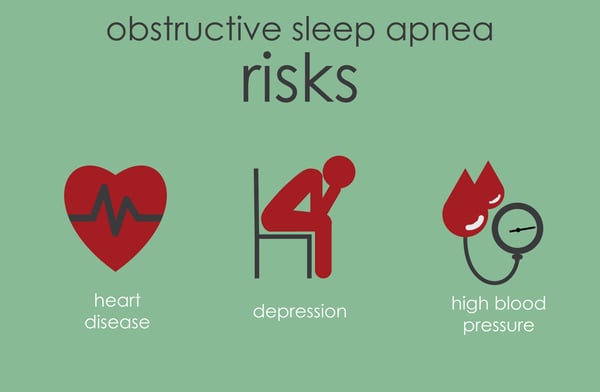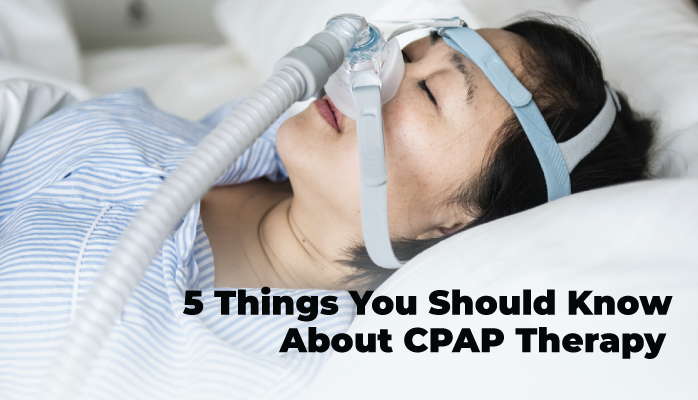What is CPAP Therapy?
CPAP therapy is a treatment that is used to treat obstructive sleep apnea (OSA). Obstructive sleep apnea is a medical condition that causes you to repeatedly stop breathing throughout the night. With OSA, you stop breathing because your throat muscles relax, your airway becomes obstructed (by your tongue or tonsils), and you stop breathing. Each time this happens - which is many times throughout the night - you rouse to begin breathing again. Each time this cycle happens (stop breathing/waking) is referred to as an “apnea event” or apnea.
Obstructive sleep apnea can be mild to severe, depending on how often this cycle occurs:
- Mild OSA: 5-14 apneas per hour of sleep
- Moderate OSA: 15-30 apneas per hour of sleep
- Severe OSA: 30+ apneas per hour of sleep
When you stop breathing and rouse this much throughout the night (anywhere from 40 to hundreds of times throughout the night), the natural result is severe sleep deprivation. As a result, your life may be shorter, unhappier, and less performant than if you treated your sleep apnea.
This is where CPAP therapy comes in. In CPAP therapy, you use a CPAP machine to gently push air into your airway to keep it from collapsing and, in effect, to also keep you breathing and sleeping.
1 – Know What a CPAP Machine is For
A CPAP device/machine stands for Continuous Positive Airway Pressure. It is the backbone of CPAP therapy and is considered the gold standard for treating obstructive sleep apnea.
A CPAP machine is a small, rectangular box with a motorized fan inside and an adjacent humidifier. Connected to the CPAP device is a flexible tube that leads to a breathing mask. The fan creates a gentle positive pressure in the mask and delivers the pressurized air to your nose and/or mouth depending on which type of mask you have. The result, no more lapses of breathing at night because the positive air pressure keeps your airway open.
As said, there is also a humidification chamber attached to CPAP machines. Technically, a humidification chamber is optional, but most people use because lack of humidification while using CPAP devices can lead to irritation in the nasal passage and throat.
2 – Know How a CPAP Machine Works
The primary component in CPAP machines is the small fan inside. This fan delivers consistent air pressure into your mouth/nose through a connected hose between the breathing mask and CPAP device. Because of positive pressure is always delivered to your breathing passageway, your airway will not collapse when your throat muscles relax, and hence you keep breathing. Without a CPAP machine, your airway would become blocked (e.g., by your tongue or tonsils) and you would have to rouse.
In terms of components, the hose is a lightweight, flexible tube that is kept warm in order to reduce condensation. Among other things, too much condensation can lead to sanitation problems like, namely, mold growth.
The air pressure is gentle, and though can be a little strange at first, it’s rare that people report any long terms problems with it.
3 – Know Why You Would Use CPAP Therapy
Without CPAP therapy, your OSA would cause you to stop breathing anywhere from 5 to 100 times per hour. If left untreated, your sleep apnea would cause severe sleep deprivation - the long term consequences of which you should pay attention to:
- Shortened life expectancy
- Lower quality of life
- Lower performance in all areas of life
- Heart disease and other heart related problems.
Avoiding things like taking years off your life expectancy are good reasons why to use CPAP therapy.

4 – Know Facts About CPAP Effectiveness
CPAP therapy, simply put, is incredibly effective at relieving OSA symptoms and risks. It has been around for over 30 years and is the standard OSA treatment for most people.
Countless people who have OSA often say things like: I can’t sleep without my CPAP machine, or My CPAP machine changed my life, or I’m so much happier since I started using it.
In other words, it’s completely effective for the vast majority of people with OSA.
5 – Know Potential Irritations Using CPAP
It’s very uncommon for someone to have chronic problems getting to sleep with their CPAP machine. That being said, it's good to know what some of the complains are:
- The CPAP mask takes a few days to get used to
- The positive air pressure is strange at first
- Some variations of face masks don’t work with my face shape
- I have to switch between a couple face mask types (full-face mask, nasal mask) to avoid strap marks
- CPAP machines make it a little uncomfortable to get to sleep
By and large though, any discomfort faced with wearing a CPAP is far outweighed by the effectiveness of CPAP therapy in treating sleep apnea and the many health problems (i.e., less life, lower quality life, worse performance, heart problems) that accompany sleep apnea.
If you have questions about your CPAP device, about getting treatment for OSA, or about starting CPAP therapy, and you live in Alaska, please don't hesitate to reach out to us - start by taking this free online sleep test:


